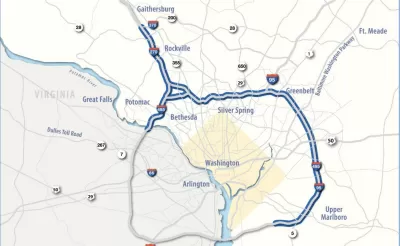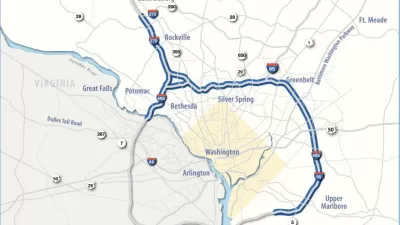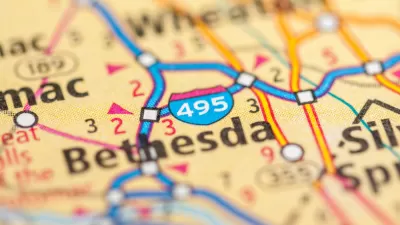The state of Maryland is moving forward with a highway widening plan that would spend $11 billion in a private-partnership to add toll lanes to two Capital Beltway highways.

"The state of Maryland has released its long-awaited draft environmental impact assessment for the Hogan administration’s controversial Beltway expansion project," reports Margaret Barthel.
The environmental review for a plan that would widen parts of I-495 and I-270 in Montgomery and Prince George’s counties totals 18,000 pages. The project would add new highway capacity by adding express toll lanes or high-occupancy toll lanes, and the estimated $11 billion price tag would be covered in part by a public-private partnership.
According to Barthel, the study argues that the project would mitigate worsening traffic congestion and meet the demands of expected population growth.
The report reduced the number of alternatives on the table from 15 to seven, but all the remaining project alternatives are likely to have significant impact, according to Barthel's explanation of the report.
But all seven options would have significant environmental impact, the study determined. In all seven, more than 140 acres of public parks and historic sites could be affected, as could more than seventy acres of wetland. Close to 1,400 acres of forest canopy would be cleared, damaged, or disturbed.
Under all seven options, about 34 residential homes and four businesses would have to be relocated. More than 4,000 noise-sensitive land areas–like homes, schools, churches, and parks–could be impacted by the sound of the expanded highway.
More on the response of critics, who have voiced vocal opposition to the project before, is included in the source article.
FULL STORY: Maryland Publishes 18,000-page Environmental Impact Assessment Of Proposed I-270 And I-495 Expansion

Study: Maui’s Plan to Convert Vacation Rentals to Long-Term Housing Could Cause Nearly $1 Billion Economic Loss
The plan would reduce visitor accommodation by 25,% resulting in 1,900 jobs lost.

North Texas Transit Leaders Tout Benefits of TOD for Growing Region
At a summit focused on transit-oriented development, policymakers discussed how North Texas’ expanded light rail system can serve as a tool for economic growth.

Using Old Oil and Gas Wells for Green Energy Storage
Penn State researchers have found that repurposing abandoned oil and gas wells for geothermal-assisted compressed-air energy storage can boost efficiency, reduce environmental risks, and support clean energy and job transitions.

Santa Barbara Could Build Housing on County Land
County supervisors moved forward a proposal to build workforce housing on two county-owned parcels.

San Mateo Formally Opposes Freeway Project
The city council will send a letter to Caltrans urging the agency to reconsider a plan to expand the 101 through the city of San Mateo.

A Bronx Community Fights to Have its Voice Heard
After organizing and giving input for decades, the community around the Kingsbridge Armory might actually see it redeveloped — and they want to continue to have a say in how it goes.
Urban Design for Planners 1: Software Tools
This six-course series explores essential urban design concepts using open source software and equips planners with the tools they need to participate fully in the urban design process.
Planning for Universal Design
Learn the tools for implementing Universal Design in planning regulations.
Ascent Environmental
Borough of Carlisle
Institute for Housing and Urban Development Studies (IHS)
City of Grandview
Harvard GSD Executive Education
Toledo-Lucas County Plan Commissions
Salt Lake City
NYU Wagner Graduate School of Public Service





























